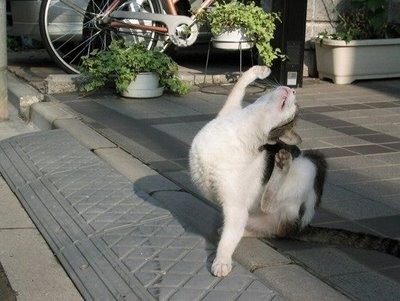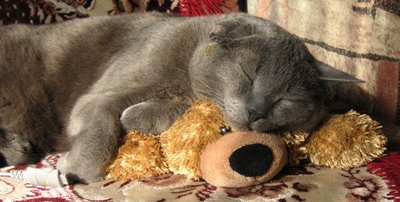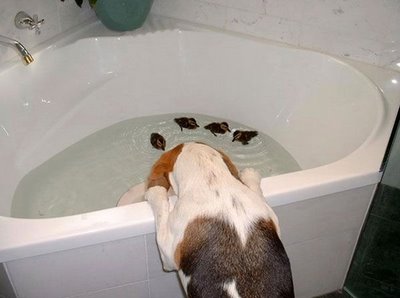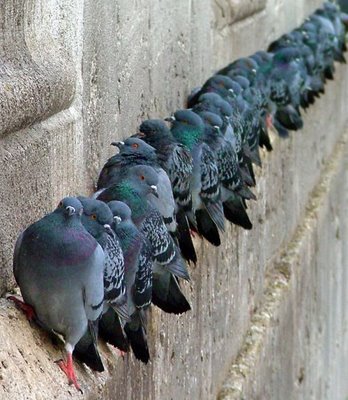by Jim Curtis
Few animals have been bestowed by humans with as many 'faces' as bottlenose dolphins. As mystical healers we pray to them, as smiling entertainers we applaud them, and as new age ambassadors we worship them. The one thing we seem to do very little of is to accept them for what they really are - wild animals. So when scientific studies emerge of bottlenose dolphins behaving in a way that we are not instantly accustomed to, we tend to respond with shock and disbelief. But such responses are symbolic of how naive and idealistic we have become towards one of the most popular species within the animal kingdom.
Most articles on bottlenose dolphins mention the following pieces of standard information:
* they are warm-blooded, air breathing marine mammals that inhabit temperate and tropical waters;
* they belong to the order Cetacea, the suborder Odontoceti, the family Delphinidae and have the species name Tursiops truncatus;
* their sleek, streamlined and powerful bodies allow them to reach speeds of up to 35 km/h;
* they can grow to a size of approximately four metres and a weight of 650 kilograms;
* they are cooperative hunters that feed on a variety of fish, squid and crustaceans;
* females have a gestation period of about 12 months and are capable of having a calf every two to three years;
* they use a process called 'echolocation' to assist with navigation and hunting;
* they travel in social units called 'pods'; and
* they have an average life span of about 25 years.
But descriptions of bottlenose dolphins are rarely confined to such pure scientific data. Subjective notions of healers, saviours, telepathic communicators and other miraculous and mystical identities are also regularly written about bottlenose dolphins. Instead of being supported by empirical evidence, these portrayals are often based more on legends, emotions
and biased personal accounts. However, despite their questionable foundations, they have helped create a modern day image of bottlenose dolphins that has detracted from their simple and foremost existence as wild animals.
This fact has rarely been more obvious to me than during the time I worked for a tourism operation in Australia that specialised in providing people with the opportunity to observe and swim with wild bottlenose dolphins in their own natural environment.
To ensure the dolphins' protection, the trips were conducted under a very precise set of government regulations. These regulations included conditions such as no feeding or touching of the animals, strict limits on approach distances and passenger numbers, and that no dolphin swim could commence if a young calf is present. But despite the existence of such regulations, and our promotional material clearly stating 'Swimming with wild bottlenose dolphins in their own natural environment', I was amazed by some of the inquiries we would receive from the public. For example, people would ask how many dolphins would each swimmer get to 'play' with in the water, and whether they could 'ride' on the dolphins' backs just like they had seen at a marine theme park. Another person who had made a booking with our operation was very disappointed when he arrived at our boat and discovered that swimming with wild dolphins did not involve an enclosed swimming pool. Such attitudes made me realise how rare the idea of a wild bottlenose dolphin has become within today's society.
Further evidence of the public's distorted view of bottlenose dolphins emerged in 1999 with newspaper articles entitled 'Dolphins Behaving Badly' and 'Jack the Flipper' (as opposed to the notorious killer, 'Jack the Ripper'). These articles referred to the findings of scientific studies carried out in both America and Scotland that provided the first ever evidence of infanticide within a cetacean species. The origins of these findings began with the realisation that bottlenose dolphins were killing other marine mammals such as porpoises. Through a combination of physical and observational evidence, researchers discovered that bottlenose dolphins were responsible for approximately 60% of harbour porpoise deaths in an area along the north-east coast of Scotland. Dolphins would chase the porpoises and ram their bodies with such force that they would be thrown into the air. This would cause a massive twisting injury within the porpoise's body, ripping blubber and muscle from its bones. Once the porpoise was dead, the dolphins would immediately lose interest and swim away.
Post-mortems on the carcasses revealed the true extent and ferocity of these attacks. Broken ribs, torn tissue, bruised organs, punctured lungs and smashed skulls and vertebrae were often the results of the dolphins' brutal and fatal beatings. The motivation for these attacks remains an unanswered question. Theories related to food competition, sexual frustration, simple aggression, rough play and dolphins defending their young have all been proposed.
-----------------------------------------------------
Unlike most wild animals that kill for food, the dolphins did not eat the victims of their attacks, and so their murderous urges were unrelated to the need for food.
-----------------------------------------------------
When similar injuries were discovered in the dead bodies of baby bottlenose dolphins, researchers suspected that adult dolphins were the culprits. Their suspicions proved to be correct, with many of the young dolphins suffering the same violent fate as their cetacean cousins. Once again, numerous theories have been proposed concerning the deaths. One of the most popular is that competing adult males may be killing the offspring of their rivals so that the dead dolphin's mother will be receptive to mating. Researchers believe that females remain sexually inactive for years when raising their young, but become active again soon after their loss. This murderous behaviour is not an uncommon feature within the animal kingdom. Large terrestrial carnivores, such as bears and lions, have been known to perform similar acts of infanticide to help start up their own dynasties to compete with their rivals. However, such behaviour had never been witnessed in a cetacean species until now, and very few people would have guessed that bottlenose dolphins would be the first one to illustrate how evolutionary pressures in the marine world can be quite similar to those in the terrestrial world.
Despite the disturbing and surprising nature of these scientific studies, it is unlikely that they will harm the benign and popular appeal of bottlenose dolphins. Although this appeal has been useful in generating support for their protection, it has also contributed to creating an image of bottlenose dolphins that extends far beyond than just being a wild animal. It is an image that has taken them out of the context of their wild domain and assimilated them into a more human one. They have been given roles as healers, entertainers and gods for the benefit of an adoring and needy public. But bottlenose dolphins have an existence that is independent of human desires and expectations, and so these studies are probably a timely reminder that they are naturally wild animals and not domesticated pets.
The intelligent, playful and caring qualities inherent to many aspects of bottlenose dolphin behaviour can at times resemble human behaviour at its best. This fact has undoubtedly contributed to their considerable universal appeal.
-----------------------------------------------------
But we now know that the behaviour of bottlenose dolphins can also resemble humans at their worse.
-----------------------------------------------------
The one animal that we believed would always be totally 'innocent', and trusted with our idealistic virtues of peace and well-being, has now shown us that it is just as capable of disturbing behaviour as humans. Bottlenose dolphins have therefore been bestowed with yet another 'face', but it is one that we never expected to have in common with them.













